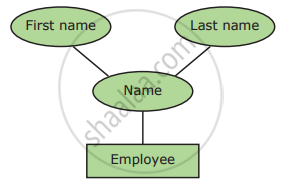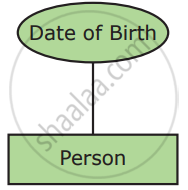Advertisements
Advertisements
प्रश्न
List the basic concepts of ER Model with suitable example.
उत्तर
The basic concepts of ER model consists of
- Entity or Entity type
- Attributes
- Relationship
These are the general concepts which help to create an ER diagram and produce an ER model. With the help of these any database design can be created and viewed to know the concept in that database design.
- Entity or Entity type-
An Entity can be anything a real-world object or animation which is easily identifiable by anyone even by a common man. Eg: In a company’s database Employee, HR, Manager are considered as entities, where each of these entity will be having its own attributes. An entity is represented by a rectangular box.
Types of Entity:
- Strong Entity:
A Strong entity is the one that doesn’t depend on any other entity on the schema or database and a strong entity will have a primary key with it (i.e. a unique id which other entities will not have in their attributes).It is represented by one rectangle. In the above example it is a strong entity because it has a primary key(a unique id) as the roll no because for every one roll no varies and it will not be the same.
- Weak Entity:
A weak entity is dependent on other entities and it doesn’t have any primary key like the Strong entity. It is represented by double rectangle. For Example: Here the marks is the weak entity and there are no unique id or primary – key for that entity. So they are dependent on the existence of the other entity.
-
Entity Instance:
Instances are the values for the entity if we consider animals as the entity their instances will be dog, cat, cow… Etc.
So an Entity Instance denotes the category values for the given entity.
- Attributes-
An attribute is an information about that entity and it will describe, quantify, qualify, classify, and specify an entity. An attribute will always have a single value, that value can be a number or character or string.
Types of attributes:
- Key Attribute:
Generally a key attribute describes a unique characteristic of an entity. - Simple Attribute:
The simple attributes cannot be separated it will be having a single value for their entity. For Example: Let us consider the name as the attribute for the entity employee and here the value for that attribute is a single value.
- Composite Attributes:
The composite attributes can be sub-divided into simple attributes without change in the meaning of that attribute. For Example: In the above diagram the employee is the entity with the composite attribute Name which is sub-divided into two simple attributes first and last name. - Single Valued Attributes:
A single-valued attribute contains only one value for the attribute and they don’t have multiple numbers of values. For Example Age- It is a single value for a person as we cannot given a number of ages for a single person, therefore it is a single-valued attribute.
- Multi-Valued Attributes:
A multi-valued attribute has more than one value for that particular attribute. For Example:
Degree – A person can hold n number of degrees so it is a multi-valued attribute.
- Relationship Type-
In ER Model, a relationship exists between two entities. Three types of relationships are – available and the Entity-Relationship(ER) diagram is based on the three types listed below.
- One-to-One relationship:
Consider two entities A and B. one-to-one (1:1) relationship is said to exist in a relational database design, if 0 or 1 instance of entity A is associated with 0 or 1 instance of entity B, and 0 or 1 instance of entity B is associated with 0 or 1 instance of entity A.
- One-to-Many relationship:
Consider two entities A and B. one-to-many (1:N) relationship is said to exist in a relational database design, for 1 instance of entity A there exists 0 or 1 or many instances of entity B, but for 1 instance of entity B there exists 0 or 1 instance of entity A.
- Many-to-Many relationship:
Consider two entities A and B. many-to-many (M:N) relationship is said to exist in a relational database design, for 1 instance of entity A there exists 0 or 1 or many instances of entity B, and for 1 instance of entity B there exists 0 or 1 or many instance of entity A.
In reality, one-to-one are in less usage, where as one-to-many and many-to-many are commonly used. However in relational databases, many-to-many are converted into one-to-many relationships.
APPEARS IN
संबंधित प्रश्न
An entity set that does not have enough attributes to form a primary key is known as ______.
Define Single valued attributes.
Define multi-valued attributes.
What is a Relationship and List its types?
Discuss on Cardinality in DBMS.
Discuss in detail on various types of attributes in DBMS.
